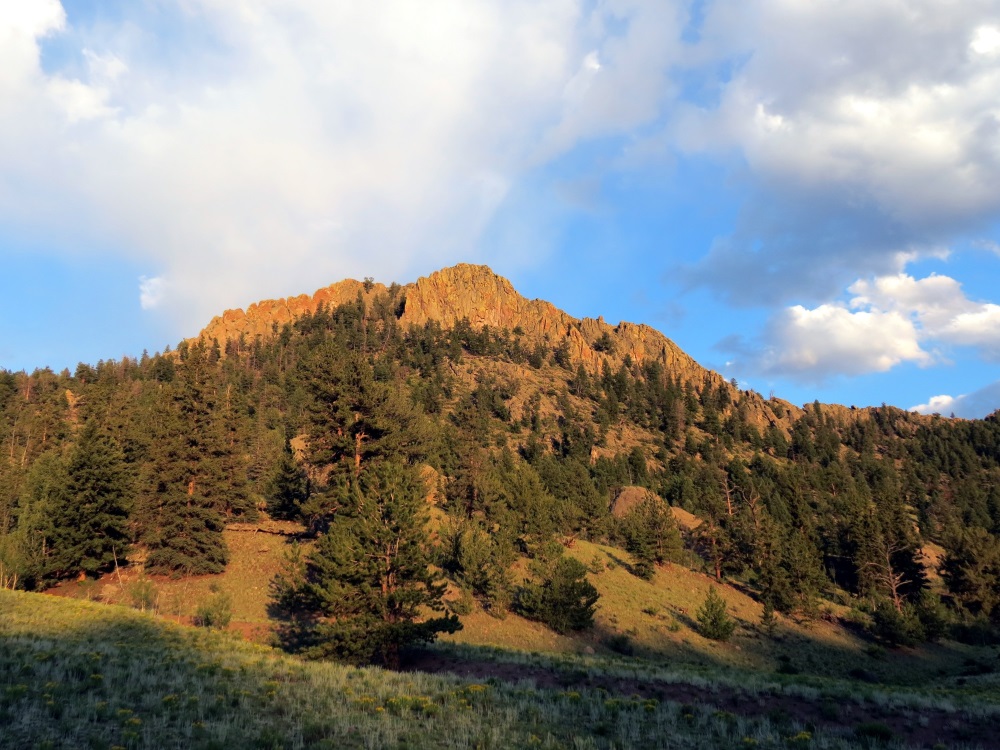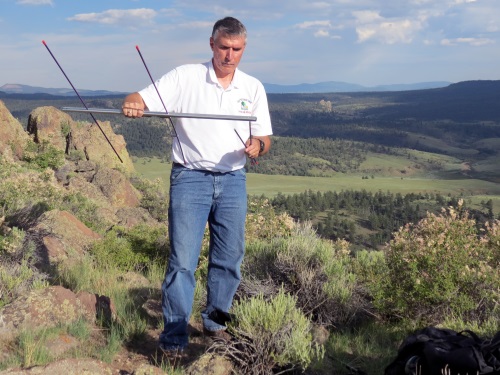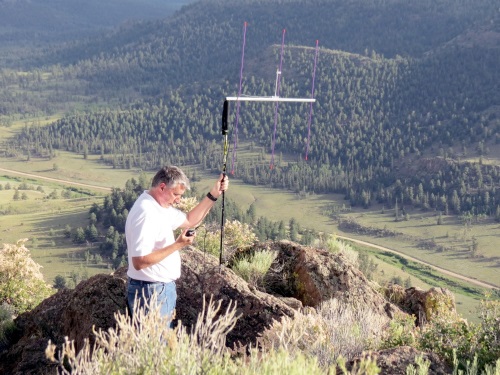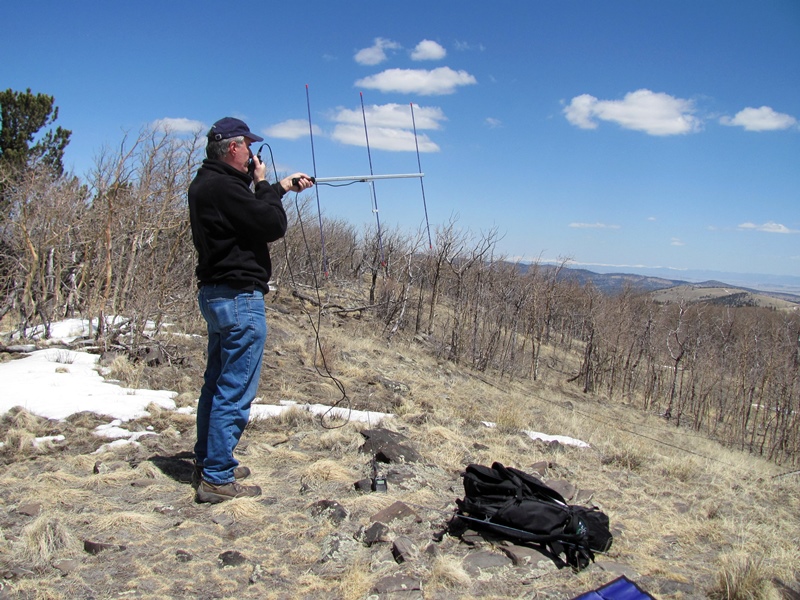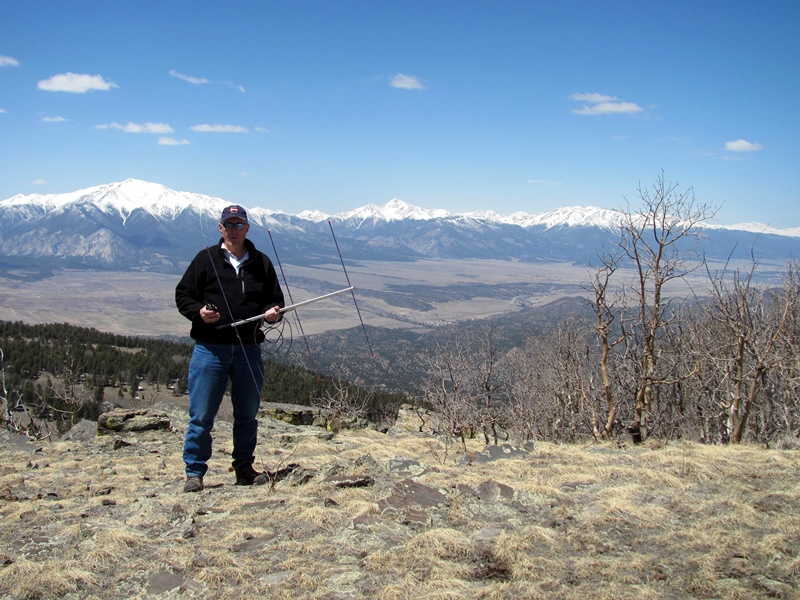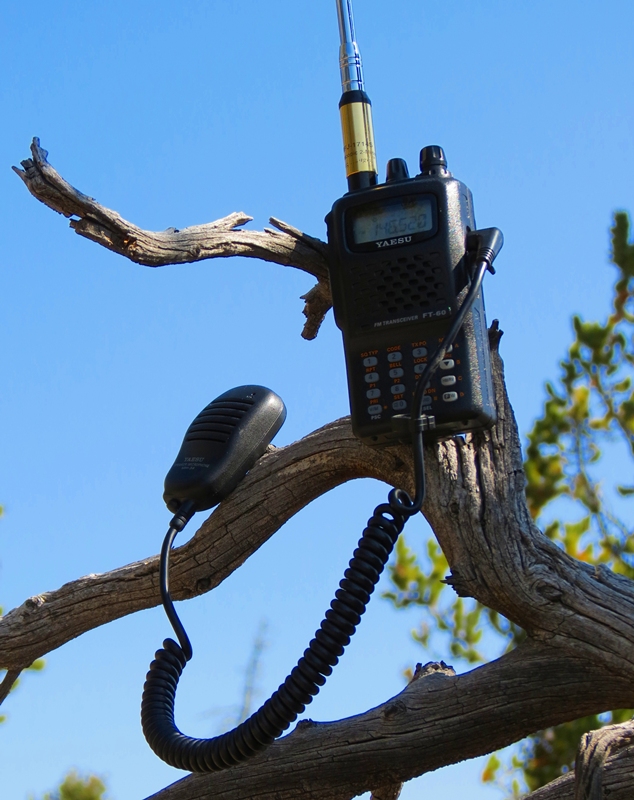Posts Tagged ‘Mountains’
 Summits On The Air (W0/SP-112) – Castle Rock
Summits On The Air (W0/SP-112) – Castle Rock
There is a very jagged peak just east of Buena Vista, CO called Castle Rock (not to be confused with the city by the same name). I knew this was a SOTA summit (W0/SP-112) and I had my eye on it for a while now. It is extremely rocky and jagged near its summit, so I was not sure if it could be ascended without a technical climb. A little research revealed that it was climbable but quite steep near the top. SummitPost.org has a good description of how to ascend this peak.
My hiking partner and wife, Joyce K0JJW, joined me on the climb. We managed to get off the preferred route and got into some very steep rock scrambling. Good judgment prevailed and we regrouped and found a more reasonable path but probably cost us an extra hour of hiking. As advertised, it did get very steep at the top. (Study the SummitPost information more carefully than I did.)
Recently, I picked up an Arrow 3-element Yagi antenna for 2 Meters (Model 146-3). This antenna can be dismantled and carried inside a reasonable size daypack (or strapped on externally). The boom has two threaded holes for mounting the antenna on a camera tripod. I used a MountainSmith trekking pole that can double as a camera monopod and mounted the antenna on it.
For this SOTA activation, I kept it simple and just used my Yaesu FT-60 to work 2 Meter FM. Accordingly, I configured the Yagi antenna for vertical polarization. (There are two mounting holes on the boom, so you can choose vertical or horizontal orientation.)
The trekking pole is not self-supporting and does not provide much additional antenna height but it makes the antenna a lot easier to point for extended periods of time. I like to use a trekking pole for hiking, so this is a good way to get a little extra utility out of it. I am pleased with how this antenna system performed and will use it again.
73, Bob K0NR
 The WG0AT List of SOTA Resources
The WG0AT List of SOTA Resources
Here’s a great set of Summits On The Air (SOTA) links from Steve WG0AT:
| Name: | Medium: | Source: | Description: |
|---|---|---|---|
| Official SOTA Site | Web | SOTA UK | Gateway to all official SOTA resources |
| Rules & Guidelines | SOTA UK | General Rules & Guidelines for SOTA | |
| WØ SOTA Site | Web | WØ Assoc.Mgr | A good place to start for SOTA info for the WØ region |
| WØ Association Reference Manual (ARM) | WØ Assoc.Mgr. | Defines all summits and rules for the WØ Association | |
| SOTA Activator Guidelines | SOTA UK | The rules summarized on one page | |
| SOTAwatch: Alerts | Web | SOTA UK | Create activation alerts for the world to see (You have to sign-up for a free account) |
| NA SOTA (Yahoo Group) | Web | 3rd party: Yahoo | The NA-SOTA Group on Yahoo is a great place to meet fellow Chasers/Activators, announce activations and share experiences. You have to submit a ‘join’ request before getting access |
| Results & Summits Database | Web | SOTA UK | Submit activation logs, search for summits, view results etc. |
| Adventure Radio: Mapview | Web | 3rd party: Mario/DC7CCC | Google map overlay. Allows to search for SOTA summits based on Assoc./Region or grid locator. |
| How to Activate a SOTA Peak | 3rd party: Guy/N7UN | Guy/N7UN’s helpful 4-page summary of the steps involved from planning, posting an activation Alert, conducting the activation itself and post-activation activities. | |
| WØ Summits | Web | WØ Assoc.Mgr. | Find a summit in your WØ region |
| Colorado 14er Event | Web | 14er Event | The web site for the Colorado 14er Event (includes SOTA activations) |
| SMS Gateway | Phone | SOTA UK: Andy | SMS gateway for selfspotting. You have to register with Andy: mm0fmf_sota (at) intermoose dot com |
| SOTA Goat iPhone appy | iTunes | iTunes | Spotting app for your iOS device at the iTunes store |
| SOTA Spot Monitor App | web | Eric KU6J | SOTA spotting app for Windows PCs |
 New Colorado 14er Event Shirt
New Colorado 14er Event Shirt
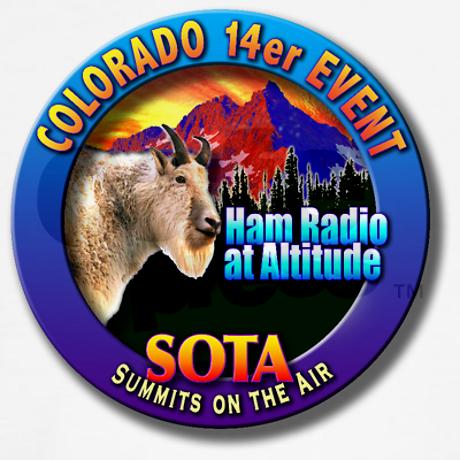 Thanks to Steve WG0AT, we now have a new design for the Colorado 14er Event Shirt. Steve gen’d up a new logo that has the Colorado 14er Event blended with Summits On The Air (SOTA), that is available on a variety of t-shirts, a coffee mug and maybe a few other items. The logo, shown to the left, is a fantastic graphic featuring Ham Radio at Altitude.
Thanks to Steve WG0AT, we now have a new design for the Colorado 14er Event Shirt. Steve gen’d up a new logo that has the Colorado 14er Event blended with Summits On The Air (SOTA), that is available on a variety of t-shirts, a coffee mug and maybe a few other items. The logo, shown to the left, is a fantastic graphic featuring Ham Radio at Altitude.
Go to Cafepress to view and purchase the items that are available.
73, Bob K0NR
 A Simple Wilderness Protocol: 146.52 MHz
A Simple Wilderness Protocol: 146.52 MHz
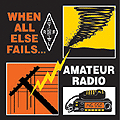 “The Wilderness Protocol” (ref. June 1996 QST, page 85), recommends that stations (fixed, portable or mobile) monitor the primary (and secondary if possible) frequency(s) every three hours starting at 7 AM local time, for five minutes (7:00-7:05 AM, 10:00-10:05 AM, etc.) Additionally, stations that have sufficient power resources should monitor for five minutes starting at the top of every hour, or even continuously.” The primary frequency is the National Simplex Calling Frequency…146.52 MHz. The secondary frequencies are 446.0, 223.5, 52.525 and 1294.5 MHz.
“The Wilderness Protocol” (ref. June 1996 QST, page 85), recommends that stations (fixed, portable or mobile) monitor the primary (and secondary if possible) frequency(s) every three hours starting at 7 AM local time, for five minutes (7:00-7:05 AM, 10:00-10:05 AM, etc.) Additionally, stations that have sufficient power resources should monitor for five minutes starting at the top of every hour, or even continuously.” The primary frequency is the National Simplex Calling Frequency…146.52 MHz. The secondary frequencies are 446.0, 223.5, 52.525 and 1294.5 MHz.
Here in Colorado, the summer months mean that many people head for the mountains. Mobile phone coverage has improved in many parts of the high country but is still not reliable in all areas. Amateur radio VHF/UHF repeater coverage is extensive but also does not cover the entire state.
The Wilderness Protocol is a good idea but is overly complex for practical use. Here’s my proposal to make it much simpler for practical backcountry use:
Principle #1: Don’t ever rely on a radio or mobile phone to get you out of trouble in the backcountry. Your primary strategy must be self-sufficiency. Avoid trouble. Be prepared for the unexpected.
Principle #2: Know what repeaters are available in your area. We have many wide coverage repeaters available but you need to know the frequency, offset and CTCSS tone (if any). The Colorado Connection is a linked repeater system that covers many remote parts of the state.
Principle #3: In remote areas, monitor 146.52 MHz as much as possible. This applies to backcountry travelers, mobile stations and fixed stations.
I’ve been making it a habit to monitor 146.52 MHz in the backcountry. I often come across hikers, campers, fisherman, 4WD enthusiasts, SOTA stations, mobile operators and others monitoring that frequency. It is fun to chat with other radio amateurs having fun in the mountains.
Just my opinion.
73, Bob K0NR
Note: This is a repost of an older article with minor edits.
 SOTA Activation: Aspen Ridge (W0/SP-084)
SOTA Activation: Aspen Ridge (W0/SP-084)
Spring is finally coming to the Colorado high country so it was time for a SOTA (Summits on the Air) activation. I don’t know which idea comes first: let’s go hiking or let’s play SOTA. I suppose it doesn’t really matter.
I’ve had my eyes on activating Aspen Ridge, which is near our family cabin but I wasn’t sure if the road was open. It turned out to be an easy Jeep ride down Forest Service Road 185 to get close to the summit. Then a half mile hike around and over the occasional snow patch got Joyce K0JJW and me to the summit.
My portable station was a Yaesu FT-60 handheld and a couple of antennas. Shown above is my dualband Arrow II antenna with only the 2 Meter elements installed, resulting in a 3-element Yagi antenna. My other antenna is an omni-directional MFJ-1714 1/2-wave whip antenna, which is a little easier to handle for general use. Often that is the only antenna I bring along but this time I decided to add a few more dB of signal by using the Yagi. I also take along a Yaesu VX-8GR that pings my location on APRS (www.aprs.fi/k0nr-7).
After a few calls on 146.52 MHz FM, I worked KC8I in Woodland Park. A few minutes later, I caught Steve WG0AT operating from another SOTA peak (Mt Herman, W0/FR-063) for the QRP To The Field contest. A little later, I worked Ted N0ZPX who was fishing at Antero Reservoir, then N0VXE mobile near Salida and Ron N0MQJ in Ranch of the Rockies.
This photo shows the beautiful Collegiate Peaks in the background, with plenty of snow still showing. Needless to say, it is a gorgeous view from Aspen Ridge!
73, Bob K0NR
 VHF SOTA Activation (W0/ SP-081)
VHF SOTA Activation (W0/ SP-081)
It was another great day for Summits On The Air (SOTA) activity. I hiked up to Kaufman Ridge HP (W0/SP-081) with Joyce K0JJW to do the first SOTA activation of that summit. This summit is just south of Kaufman Ridge North (W0/SP-085) mentioned in this post.
Unlike some of my previous SOTA activations, I actually kind of sort of planned this one. I had my Yaesu FT-60 HT with a decent omni antenna for 2 Meters (the MFJ-1714). I also took along the VX-8GR handheld for use as an APRS station. Note the innovative In The Tree mounting scheme for the FT-60:
On the way up, I heard Steve WG0AT on the summit of Mount Rosa (W0/FR-034) calling on 146.52 MHz. I gave a quick call to Steve to let him know I was hearing him but that I was not at the summit yet. About 20 minutes later, I was on top and worked Steve and his hiking partner Frank K0JQZ, for a summit-to-summit contact.
A call on 146.52 MHz got a reply from John N0EVH who was operating mobile. Then I worked Bill KD0PFF who was driving up a 4WD road to Red Cone Peak. Later, I worked his 4WD partner Stan KD0PFC. Fred WA0SIK, a regular in the various VHF contests, came up on five two to give me another contact. Then I got a call from Dave K0HTX who spends many weekends over on the other side of South Park. Finally, I caught Randy KN0TPC and Jeremy KD0MWT on 147.555 MHz, near Divide at a Boy Scout Camporee.
It was really cool to catch all these folks out having fun in the mountains. It was a glorious fall day and the aspen trees were at their peak fall color.
73, Bob K0NR
 Ham Radio Action Next Weekend – Sept 8/9
Ham Radio Action Next Weekend – Sept 8/9
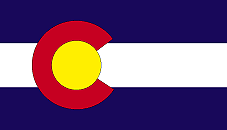 There are three excellent ham radio activities going on this coming weekend. Check these out and see if there is an activity that catches your interest. This is written for people in Colorado but items #1 and #3 are North American wide.
There are three excellent ham radio activities going on this coming weekend. Check these out and see if there is an activity that catches your interest. This is written for people in Colorado but items #1 and #3 are North American wide.
- ARRL September VHF QSO Party – noon MDT on Saturday until 9 PM MDT on Sunday http://www.arrl.org/september-vhf
- Colorado FM Sprint – a mini version of the September VHF QSO Party,
using FM only on these bands: 146 MHz, 222 MHz and 440 MHz
Saturday from noon to 7 PM MDT
http://www.qsl.net/k0yb/Colorado_FM_Sprint.html
Suggested frequencies: 146.58, 146.55, 223.5, 446.000, 446.100 MHz FM simplex - North American Summits On The Air (SOTA) Weekend
SOTA activations all over North America
http://na-sota.org/NASOTA_Weekend.html
Go here to see announced summit activations: http://www.sotawatch.org/
VHF contacts are usually on 146.52 MHz
(Note: this frequency is NOT allowed for contacts in the
Sept VHF QSO Party and Colorado FM Sprint)
HF contacts are on frequencies listed on sotawatch.org
Wow, lots of stuff to choose from!
At the very least, I’d suggest getting on the air Saturday afternoon to see if you can work some of the VHF contest stations. They are likely to be some mountaintop SOTA stations active at that time, too. Some of these folks may try to work the VHF contests AND do the SOTA thing on the same expedition.
73, Bob K0NR
